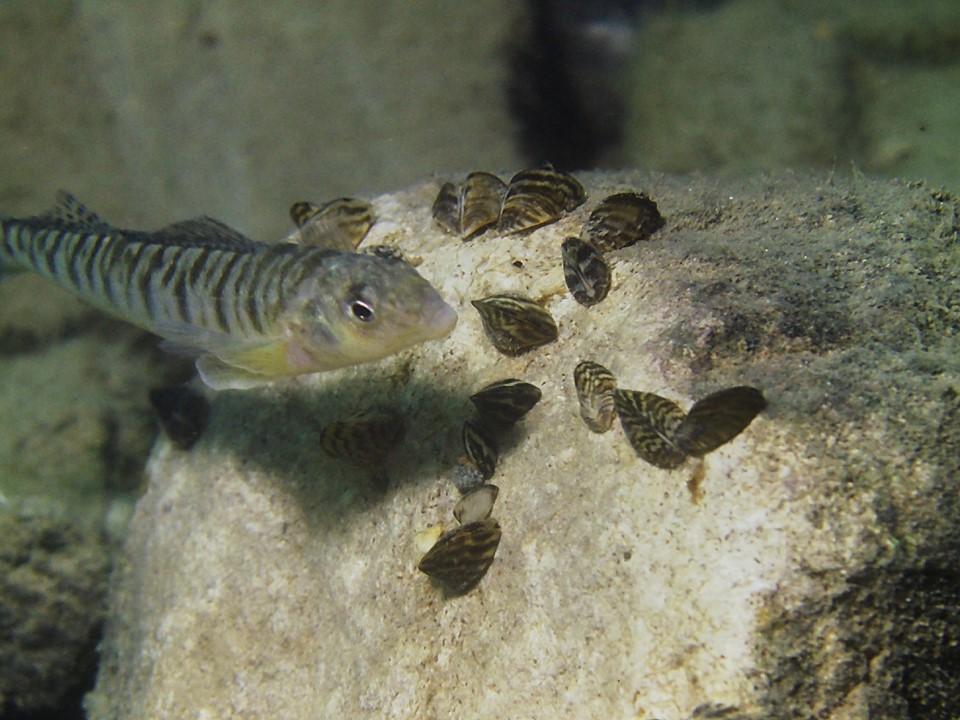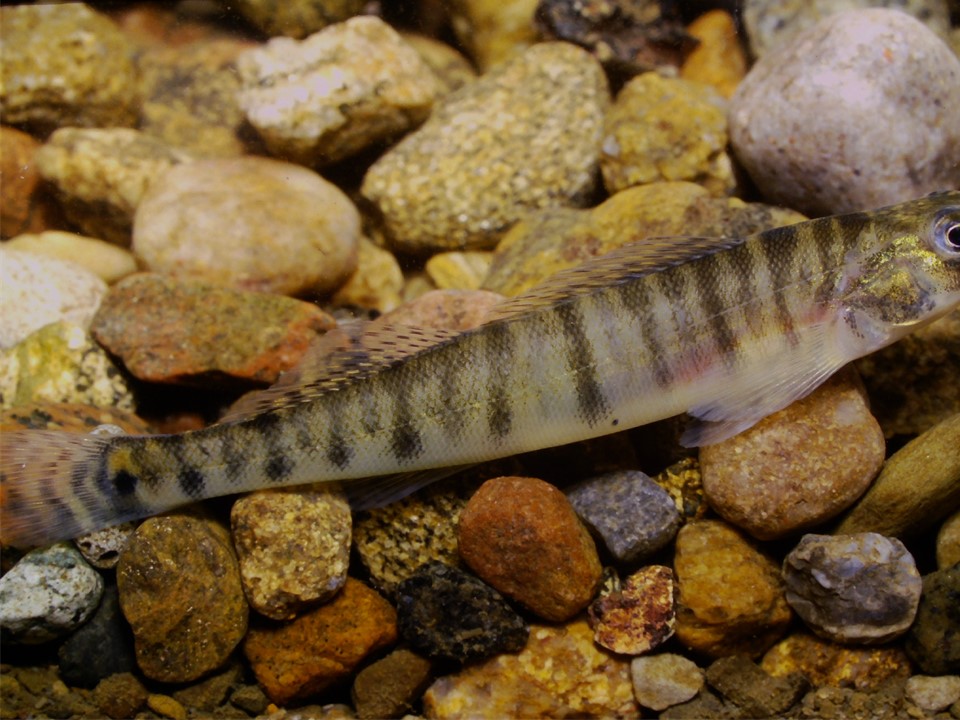
Some fish don’t seem to mind a diver’s bubbles or humans fumbling around underwater. Others bolt at my first exhalation. Some fish are super approachable while others remain wary and aloof regardless of how I try to entice them.
And some species, like the tiny logperch, don’t seem to give a fig what I do.
Logperch are aptly named as they look like tiny perch with light yellow bodies, dark stripes and a white belly. But, although they look similar to perch, logperch are a type of darter. With an average length of only 3 to 4 inches, logperch are actually the largest darter in the Great Lakes.
Unlike other darters and most bottom-dwelling fish, logperch have a swim bladder which enables them to leave the bottom. Being able to swim affords many advantages, including significantly increasing where a logperch can go.
When I started diving, logperch were the most abundant fish on the river bottom. I saw schools of them near the seawall, under docks, around wrecks, on sand bars, in grass beds and out on the sturgeon spawning grounds where the current is so fast, I’m amazed the little fish can manage it.
Logperch are long and skinny with flat faces that slope sharply downward to pouty upper lips. They are the only darter whose upper lip overhangs their mouth, which makes them easy to identify. When it’s time to find food, logperch take full advantage of their flat faces.
Mayflies, dragonflies, fishflies and similar insects spend part of their life as bugs on the river bottom. Known collectively as aquatic insects, they are a critical food source for native fish like logperch and all the way up the chain to lake sturgeon.
Each species has developed unique ways of extracting the bugs from the bottom.
Logperch are called stonerollers because they literally roll stones out of their way to find their prey. I failed to appreciate the physicality of this process until I actually witnessed a stoneroller in action.
Stone flipper would be a more apt description. The little fish worked its way across the bottom, turning over every pebble, stone and rock it passed. I was genuinely shocked by the size of some stones the little fish flipped.
A logperch rolling stones is not the equivalent of me hunting for Petosky stones on the beach. It’s more comparable to Dwayne ‘The Rock’ Johnson flipping monster truck tires in a strongman competition.
It wiggles its snout under one edge of a rock until its face is wedged between the stone and the river bottom. Then, with a quick flick of its head, it flips the stone away. Exposed bugs are consumed faster than my eyes can discern. I usually only see a flash of movement and a puff of silt before the logperch moves to the next rock.
In terms of underwater entertainment, it’s hard to beat a logperch stone rolling.

Logperch (Photo Credit: Greg Lashbrook/PolkaDot Perch)
Aside from its ideal stone-flipping design, the unique shape and toughness of the logperch’s head enables an interesting symbiosis with the snuffbox mussel.
I have an admitted fondness for freshwater mussels and their interesting reproductive processes. In my column about mussels, I describe how some mussels use lures to entice fish closer. Snuffbox do not need lures; they simply wait for a stoneroller to come along.
When a logperch wiggles its snout against a snuffbox mussel, rather than flipping over the mussel clamps down onto the logperch’s head and injects microscopic baby snuffboxes into the fish’s gills. It’s a clever and usually harmless way for the mussel to help their offspring.
A logperch’s skull is strong enough to withstand the snuffbox’s grasp, but the snuffbox can crush the skull of any other darter or tiny fish that swims within reach.
When bottom-dwelling round gobies were dumped into the lower St. Clair River by a visiting vessel, they invaded logperch territory. The two species immediately began a head-to-head battle for the bottomlands.
Logperch had the home turf advantage, but the gobies were more aggressive and had a more successful reproductive strategy. Round gobies guard their nests and hatchlings, which significantly increases the survival rate of their young. Logperch scatter their fertilized eggs on the bottom and swim away, leaving the eggs and offspring to fend for themselves.
If a logperch uncovers fish eggs while stone rolling, it will quickly devour them all. Logperch even eat logperch eggs. But logperch do not swim around looking for other species’ nest sites to raid like gobies do. Round gobies are also good at eating spawned eggs before they can be naturally distributed or can settle deeper into the protection of the river bottom.
Altogether, the round goby’s strategy of protecting their own young while specifically target the spawning and nest sites of other species proved highly effective. The scrappier invasives decimated the logperch.
As the round goby population in the St. Clair River exploded, the schools of logperch I saw correspondingly diminished until I feared it was only a matter of time before the stone rollers vanished altogether.
But, to my joyful surprise, the logperch held their ground on long enough for another native ally to join the battle.
Smallmouth bass are the predators that most bottom-dwellers fear. It took a while for the smallmouth to realize round gobies were tasty. But once the large predators figured out the gobies were good and plentiful – and worked out how to catch them – the offensive shifted. By targeting and reducing the number of gobies, the bass helped take some of the pressure off the logperch.
In the last few years, the schools of logperch I see have gotten larger and more abundant. They are nowhere near their pre-goby numbers. Still, it’s heartening to see them doing better.
Sadly, the snuffbox have not fared as well. First, the tiny native mussel took a direct hit from the zebra mussel invasion. Then the sharp decline in logperch numbers following the goby invasion further reduced the mussels’ ability to reproduce successfully.
In 2012, the U.S. Fish and Wildlife Service added the snuffbox to the federal endangered species list.
The story of logperch in the St. Clair River illustrates the critical role predators play in ecosystems. I don’t think our native logperch would have survived the round goby war without help from the bass.
Today, on the original battlegrounds in the St. Clair River, the logperch are rebounding and the goby are running scared, while the bass are fat and happy.
Catch more news on Great Lakes Now:
I Speak for the Fish: Meeting the mysterious muskie
I Speak for the Fish: Center stage alongside Great Lakes steelhead trout
Featured image: Logperch (Photo Credit: Greg Lashbrook/PolkaDot Perch)
7 Comments
-
Logperch seem to have increased their base number on the Lower Rouge River without the help of prowling Smallmouth Bass. Ten years ago we were surprised to find them for the first time in the Rouge at Inkster Road along with many goby. Over the past ten years, numbers have increased and they have moved up the Lower branch and downstream on the Main.
-Sally Petrella, Friends of the Rouge -
Each article you write is amazing ! Please keep it up !!
-
To tell the truth, it is so cool that you enlighten people about fish because there are a lot of different types which are not explored and which we are not aware of to a great extent. Before this moment I hadn’t had a clear view of Logperch and their concept, but after reading your article I explored new interesting parts of Logperch. It is so incredible that this type of fish combines all necessary and stands out with its unique visual component. Also, the fact that Snuffbox simply waits for a stoneroller to come along amazed me because, quite frankly, I have never observed something like this and the strategy of their behavior is really unusual for me, but interesting at the same time. I came to the conclusion that all types of fish stand out with their special distinctive features and you can’t find one that would be trivial and that would be completely understandable for you.
-
@Sally, it’s good to hear that you are seeing increased numbers of logperch downriver too. They are an important native species lost in rivers like the Rouge due to pollution and loss of habitat. It’s likely that all the restoration work being done in your area is helping bring them back!
-
@Sally, it’s good to hear that you are seeing increased numbers of logperch downriver too. They are an important native species lost in rivers like the Rouge due to pollution and loss of habitat. It’s likely that all the restoration work being done in your area is helping bring them back!
-
Thanks, Charles! We really appreciate the support from readers like you!!
-
@Marina, thanks so much for sharing. I completely agree about the cool factor of fish! Appreciate you taking the time to comment!!




